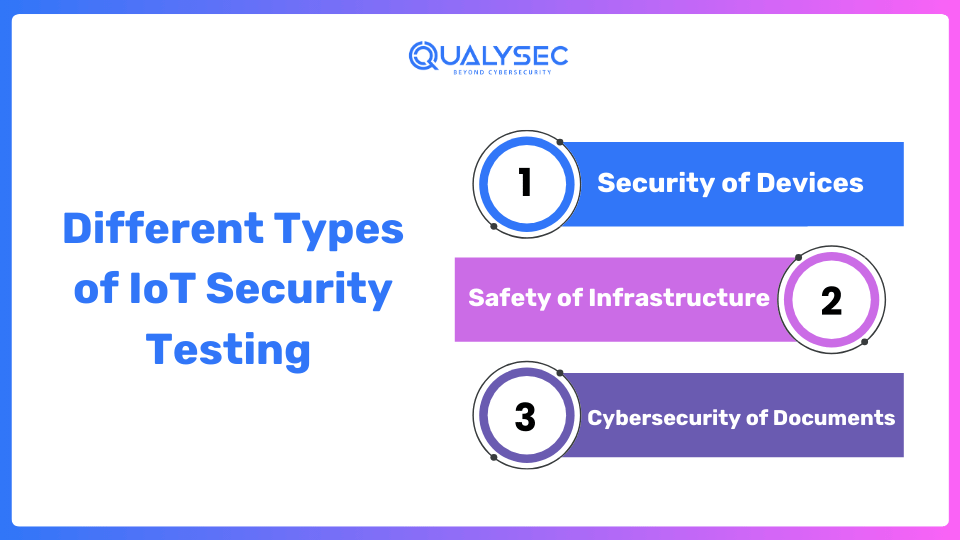
The Internet of Things (IoT) has completely transformed how people interact with technology, connecting everything from manufacturing sensors to smart home devices. However, our growing reliance on IoT devices brings significant security challenges. Securing these devices is essential to guard against cyber threats that could affect the public’s safety, company productivity, and individual privacy. This blog discusses the significance of IoT device security, testing techniques, and typical IoT device drawbacks.
From gadgets that manage home security, like electronic locks, to devices that analyze medical information, like watches, and levels, the number of connected devices has grown significantly in the past few years.
Either the organization that oversees these gadgets or the consumers that use these regularly have seen a rise in the area of attack that is open to criminals due to their wide availability.
“Also Read: What Is IoT Security? Issues, Challenges, and Best Practices
IoT device security service has several advantages, including yet not confined to the following:
Do you wish to protect your IoT devices from hackers? Tap the link below and talk to our cyber security expert and get the guidance.

Talk to our Cybersecurity Expert to discuss your specific needs and how we can help your business.
There are several tests involving securing an IoT device. To safeguard IoT devices, the top IoT security company performs the following tests:

Device security refers to protecting specific devices, such as PCs, cell phones, and Internet of Things equipment, from unauthorized access. Tight credential options, frequent software upgrades, and tools like fingerprinting that prevent hackers from accessing the device at all are all part of this. Furthermore, IoT device security services are essential for guaranteeing that IoT devices are shielded from new dangers and weaknesses.
Avoiding different kinds of breaches or assaults on channels of communication is the focus of network safety measures. To make certain that information sent via networking is safe without illegal access or manipulation, this procedure makes use of firewalls, intrusion detectors, and protection methods.
Protection of data ensures that the knowledge gathered and displayed by Internet of Things technology is private and unaltered. This includes several steps to stop unintentional entry, losses of information due to leaks, or data manipulation, including the encryption of data, access monitors, verification data storage, and transit.
“Discover more: What Is IoT Security Testing and Why It Matters!
A variety of IoT security tools are used by IOT security professionals or security experts. Top IoT security firms frequently utilize the following methods:
Increasing IoT Environment: Including Internet of Things (IoT) devices in a variety of industries, such as production, healthcare, and urban planning, the area of attack grows, and the likelihood of hacking rises. Because every device that is linked might serve as an entryway for cybercriminals, thorough checks for safety are essential.
Future Exploitation: Attackers can exploit defects in IoT devices to:
Compliance with Rules: As IoT safety standards tighten, businesses have to make certain that their gadgets adhere to regulations to prevent penalties, both monetary and criminal. Companies working in the field of Internet of Things are increasingly required to comply with safety regulations like GDPR and ISO/IEC norms.
Credibility and Confidence: The credibility of a business and confidence among consumers can be negatively impacted by security violations. A solid security architecture and trust among consumers are maintained by conducting efficient checks on security, which guarantees the safety of customers’ data and interactions with IoT devices.
“Explore Further: IoT Device Penetration Testing: Best Practices and Strategies
Despite their innovation, IoT device testing frequently includes built-in security flaws. The following represent a few of those most prevalent flaws:
The need for a robust surveillance and security system is growing along with the prevalence of technological advances and connected products. Businesses can continuously scan their systems, components, and applications for known and unknown threats or weaknesses with QualySec.
With process-centered vulnerability assessments, we also provide customized protection measures. A unique approach that makes recourse to a professional team with thorough testing expertise and a mixed testing technique to guarantee this application meets the highest standards in the market.
Additionally, we employ both proprietary and licensed tools, such as Burp Suite and Metasploit, to conduct preliminary testing and automatic detection of vulnerabilities as part of our security testing services. We constantly help firms in negotiating complex legal compliance settings, including HIPAA, GDPR, SOC2, and ISO 27001.
We help developers resolve vulnerabilities by providing extensive and developer-friendly pentesting reports. Furthermore, this report comprises all of the insights, beginning with the location of the detected vulnerabilities and finishing with a reference on how to solve them, i.e., you obtain a thorough step-by-step report on how to remedy a vulnerability.
Feel free to download the whole structure of a sample report right now!
With a worldwide presence, we’ve successfully safeguarded 250+ apps and serviced 20+ countries through a network of 100+ partners, and we’re delighted to have a zero-data-breach record. Contact QualySec now for unsurpassed digital security for your application and company.
It is far more crucial than before to ensure the integrity of devices with connectivity as the IoT environment grows. To assist businesses in safeguarding their devices against possible hazards and weaknesses, QualySec provides thorough IoT device security testing services. Working with QualySec gives you a range of professional testing services, tailored remedies, and continuous support to guarantee the safety and confidentiality of your Internet of Things infrastructure.
Use QualySecs’ state-of-the-art security testing services to protect your linked network and IoT devices. Is your IoT device security ready to be improved? To find out more about our IoT security testing services and the ways that we could assist with safeguarding your company, get in touch with QualySec right now.
The goal of IoT cybersecurity is to defend against intrusions on the hardware components and their internet interfaces. Furthermore, this guarantees the security, privacy, and reliability of IoT networks by protecting gadgets from virus assaults, illegal accessibility, and information leaks.
IoT security issues include vulnerabilities in machine verification, exposure to malicious code, ransomware, and small loads, brittle encoding procedures, simple exposure to distributed denial-of-service (DDOS) assaults, and the potential for privacy breaches from extensive information gathering and communicating.
IoT security comes in three kinds:
1. Endpoint security: preventing unlawful access to specific machines.
2. Network security: maintaining the safety of data transferred among systems and endpoints.
3. Data security: ensuring that information gathered and sent by Internet of Things devices is private and unaltered.

Pabitra Sahoo is a cybersecurity expert and researcher, specializing in penetration testing. He is also an excellent content creator and has published many informative content based on cybersecurity. His content has been appreciated and shared on various platforms including social media and news forums. He is also an influencer and motivator for following the latest cybersecurity practices.





Plot No:687, Near Basudev Wood Road,
Saheed Nagar, Odisha, India, 751007
No: 72, OJone India, Service Rd, LRDE Layout, Doddanekundi, India,560037
© 2024 Qualysec.com Disclaimer Privacy Policy Terms & Conditions


No: 72, OJone India, Service Rd, LRDE Layout, Doddanekundi, India,560037
© 2024 Qualysec.com Disclaimer Privacy Policy Terms & Conditions